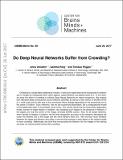| dc.contributor.author | Volokitin, Anna | |
| dc.contributor.author | Roig, Gemma | |
| dc.contributor.author | Poggio, Tomaso | |
| dc.date.accessioned | 2017-06-28T13:55:02Z | |
| dc.date.available | 2017-06-28T13:55:02Z | |
| dc.date.issued | 2017-06-26 | |
| dc.identifier.uri | http://hdl.handle.net/1721.1/110348 | |
| dc.description.abstract | Crowding is a visual effect suffered by humans, in which an object that can be recognized in isolation can no longer be recognized when other objects, called flankers, are placed close to it. In this work, we study the effect of crowding in artificial Deep Neural Networks for object recognition. We analyze both standard deep convolutional neural networks (DCNNs) as well as a new version of DCNNs which is 1) multi-scale and 2) with size of the convolution filters change depending on the eccentricity wrt to the center of fixation. Such networks, that we call eccentricity-dependent, are a computational model of the feedforward path of the primate visual cortex. Our results reveal that the eccentricity-dependent model, trained on target objects in isolation, can recognize such targets in the presence of flankers, if the targets are near the center of the image, whereas DCNNs cannot. Also, for all tested networks, when trained on targets in isolation, we find that recognition accuracy of the networks decreases the closer the flankers are to the target and the more flankers there are. We find that visual similarity between the target and flankers also plays a role and that pooling in early layers of the network leads to more crowding. Additionally, we show that incorporating the flankers into the images of the training set does not improve performance with crowding. | en_US |
| dc.description.sponsorship | This material is based upon work supported by the Center for Brains, Minds and Machines (CBMM), funded by NSF STC award CCF-1231216. | en_US |
| dc.language.iso | en_US | en_US |
| dc.publisher | Center for Brains, Minds and Machines (CBMM), arXiv | en_US |
| dc.relation.ispartofseries | CBMM Memo Series;069 | |
| dc.rights | Attribution-NonCommercial-ShareAlike 3.0 United States | * |
| dc.rights.uri | http://creativecommons.org/licenses/by-nc-sa/3.0/us/ | * |
| dc.subject | Deep Neural Networks | en_US |
| dc.subject | deep convolutional neural networks | en_US |
| dc.subject | DCNN | en_US |
| dc.subject | eccentricity-dependent | en_US |
| dc.title | Do Deep Neural Networks Suffer from Crowding? | en_US |
| dc.type | Technical Report | en_US |
| dc.type | Working Paper | en_US |
| dc.type | Other | en_US |
| dc.identifier.citation | arXiv:1706.08616 | en_US |
